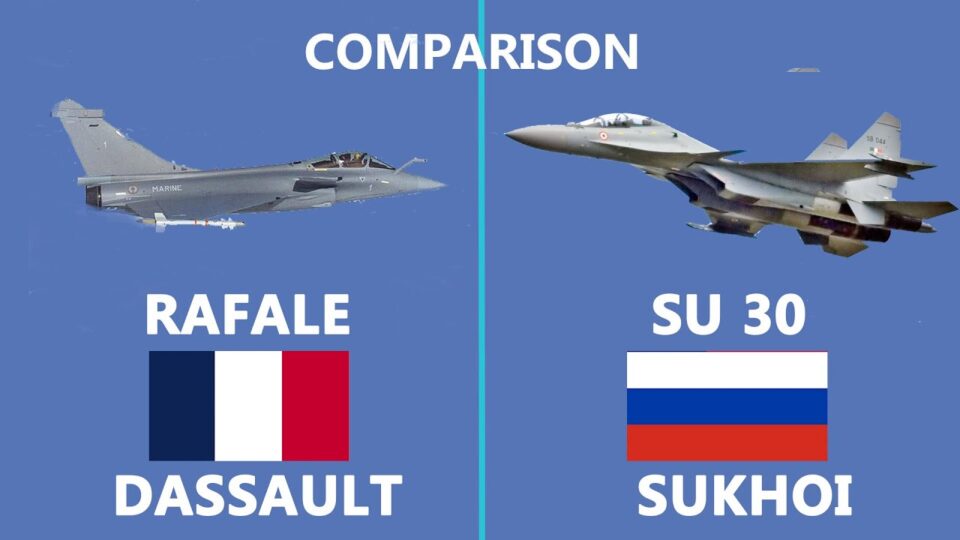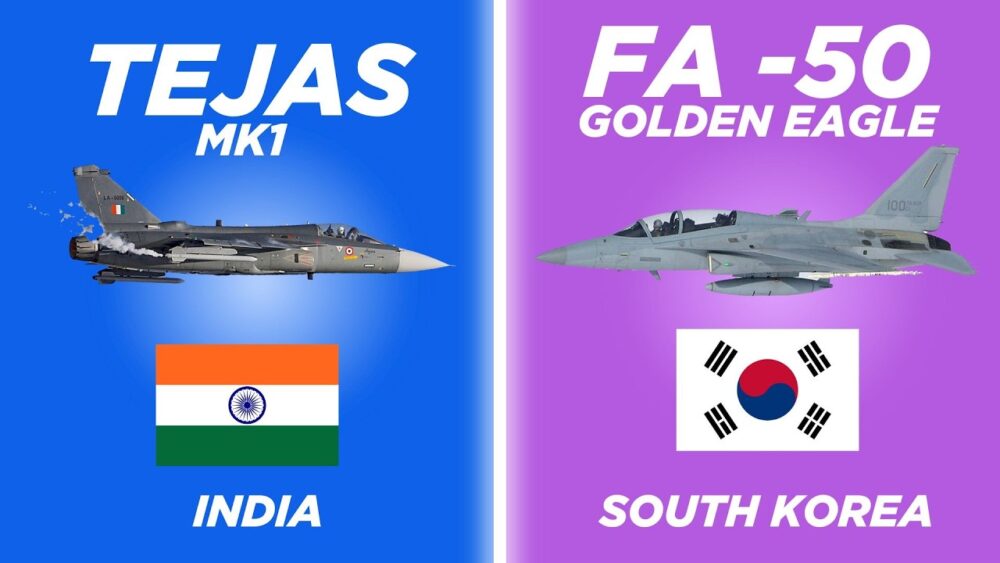Aircraft comparison
Comparison of Russian Su30 and France built Rafale fighter jet

The Su-30 and Rafale are two prominent multirole fighter aircraft that have garnered significant attention in the global defense community. The Su-30, developed by Russia’s Sukhoi, is renowned for its versatility and advanced avionics, while the Rafale, produced by France’s Dassault Aviation, is celebrated for its agility and cutting-edge technology.
In this article, we will compare both fighters, examining their design, technological advancements, and operational capabilities to understand how they stack up against each other in the competitive landscape of modern aerial warfare.
The Sukhoi Su-30 is a Russian fighter jet with two engines and seats for two pilots. It’s designed to fly in all weather and perform air-to-air and ground attacks. It can fly with autopilot and use radar to navigate at low altitudes. The Su-30 can attack both air and ground targets alone or in groups. As of 2024, about 600 of these jets have been built.
The Rafale, is highly versatile, boasting advanced avionics and a wide array of weapons capability. Its design prioritizes agility and adaptability, making it effective in various combat scenarios. As of 2023, approximately 259 Rafale jets have been built, showcasing its significant role in modern air warfare.
Both the Su-30 and Rafale are advanced multirole fighters, each with unique capabilities and design philosophies.
Length:
- The Su-30 measures 21.935 meters (72 feet ) in length, whereas the Rafale is shorter at 15.27 meters (50 feet).
Wingspan:
- The Su-30 has a wingspan of 14.7 meters (48 feet), which is notably wider compared to the Rafale’s wingspan of 10.90 meters (35 feet ).
- Max Takeoff Weight:
- The Su-30’s maximum takeoff weight is 34,500 kilograms (76,059 pounds), significantly higher than the Rafale’s maximum takeoff weight of 24,500 kilograms (54,013 pounds).
- Powerplant:
- The Su-30 is powered by two Saturn AL-31FL/FP turbofan engines, each providing 74.5 kN (16,700 lbf) thrust dry and 122.58 kN (27,560 lbf) with afterburner. In contrast, the Rafale uses two Snecma M88-4e turbofan engines, delivering 50.04 kN (11,250 lbf) thrust dry and 75 kN (17,000 lbf) with afterburner.
- Rate of Climb:
- The Su-30 has a rate of climb of 230 meters per second (45,000 feet per minute), while the Rafale boasts a superior rate of climb at 304.8 meters per second (60,000 feet per minute).
- Maximum Speed:
The Su-30 can reach speeds of up to 2,120 km/h (1,320 mph, Mach 2) at high altitude, while the Rafale has a maximum speed of 1,912 km/h (1,188 mph, Mach 1.8). - The Su-30 has a service ceiling of 17,300 meters (56,800 feet), exceeding the Rafale’s service ceiling of 15,835 meters (51,952 feet).
The Su-30 is renowned for its robust airframe, exceptional maneuverability in all axes, and its iconic “cobra” maneuver. The tactical effectiveness of the cobra maneuver has been a topic of debate for decades, with no clarity its practical application. Designed originally for ground-attack roles, the series incorporates features such as canards, thrust-vectoring engines, and a long-range phased-array radar to excel in air-superiority missions.
Meanwhile, the Rafale was meticulously crafted with reduced radar cross-section (RCS) and infrared signature in mind. Modifications from the initial technology demonstrator include tail-fin size reduction, fuselage reshaping, repositioning of engine air inlets beneath the wing, and extensive use of composite materials. Seventy percent of the Rafale’s intake surface area consists of composites, enhancing its stealth capabilities. However, many features aimed at minimizing the Rafale’s visibility to threats remain classified.
In terms of armament versatility, the Su-30 is equipped with a robust store management system that allows for the integration of a wide range of weapons and equipment. The Su-30 features 12 hardpoints for mounting various ordnance, including air-to-air missiles, air-to-ground missiles, and bombs. Additionally, it is armed with a 30 mm GSh-30-1 cannon, and it can be armed with a diverse array of weapons such as the R-27 and R-77 air-to-air missiles, precision-guided munitions, and various types of bombs.
While the Rafale utilizes a store management system compliant with MIL-STD-1760, facilitating seamless integration of various weapons and equipment. With 14 hardpoints (13 on the Rafale M version), including five suitable for heavy armaments or auxiliary fuel tanks, the rafale vs su 35 Rafale boasts a maximum external load capacity of nine tons. Additionally, it is armed with the 30 mm GIAT 30 revolver cannon and can be configured with an array of laser-guided bombs and ground-attack munitions.

Aircraft comparison
Comparison of the Indian built Tejas MK1A vs South korean FA 50

Today, we’ll explore two remarkable light combat aircraft: the Tejas MK1A and the FA-50 Golden Eagle. Both fighters are designed for versatility, making them ideal for various missions, from air-to-air combat to ground support.
The Tejas MK1A, developed by Hindustan Aeronautics Limited (HAL) in India, and the FA-50, a product of Korea Aerospace Industries (KAI), are both advanced aircraft equipped with modern technology and features.
10 Fascinating Facts About India’s AMCA Fighter Jet
In this Article, we will compare these two fighters in terms of their specifications, performance, capabilities, and roles in modern air forces. Let’s dive in and see how they stack up against each other!
Tejas is the second supersonic combat aircraft developed by Hindustan Aeronautics Limited (HAL), following the HF-24 Marut. It took its first flight in 2001 and was inducted into service with the Indian Air Force (IAF) in 2015. Currently, Tejas holds the distinction of being the smallest and lightest aircraft in its class of supersonic combat jets.
On the other hand, the FA-50 is South Korea’s first indigenous supersonic aircraft and is one of the few supersonic trainers in the world. Development of the T-50 began in the late 1990s, with its maiden flight taking place in 2002.
Russia Seeks Talks with India, Offers Tu-160 Bombers at Unbeatable Prices
The FA-50 boasts a higher production rate compared to the Tejas. Over the past 15 years, Korea Aerospace Industries (KAI) has produced nearly 200 variants of the FA-50, while Tejas has seen a lower production output.
In terms of international sales, the FA-50 is actively in service with multiple countries, including Indonesia, Iraq, the Philippines, Thailand, and Poland. Notably, Malaysia opted for the FA-50 over the Tejas, citing the FA-50’s strong service record as a key factor in their decision.
Here’s a SPECIFICATION of the Tejas and FA-50
Length: The Tejas measures 13.2 m (43 ft 4 in), making it slightly longer than the FA-50, which is 13.14 m (43 ft 1 in).
Max Takeoff Weight: The Tejas has a maximum takeoff weight of 13,500 kg (29,762 lb), compared to the FA-50’s lighter weight of 10,722 kg (23,638 lb).
Fuel Capacity: The Tejas has an internal fuel capacity of 3,060 liters (810 US gallons), while the FA-50 has a slightly lower internal fuel capacity of 2,655 liters (701 US gallons).
Powerplant: Both aircraft are powered by General Electric F404 turbofan engines, but the Tejas utilizes the F404-GE-IN20 variant with 48.9 kN (11,000 lbf) thrust dry and 85 kN (19,000 lbf) with afterburner. The FA-50 features the F404-GE-102 variant, producing 53.07 kN (11,930 lbf) thrust dry and 78.7 kN (17,700 lbf) with afterburner.
Maximum Speed: The Tejas has a maximum speed of 2,220 km/h (Mach 1.8), which is significantly faster than the FA-50’s maximum speed of 1,837.5 km/h (Mach 1.5).
Combat Range: The Tejas has a combat range of 739 km (459 mi), whereas the FA-50 has a much longer range of 1,851 km (1,150 mi).
Hardpoints: The Tejas features 9 hardpoints with a total capacity of 5,300 kg, while the FA-50 has 7 hardpoints capable of carrying up to 5,400 kg of payload.
Cost: The Tejas is priced at approximately $40 million per unit, whereas the FA-50 ranges between $30 million to $40 million per unit, making the FA-50 potentially more cost-effective depending on the variant chosen.
Weapons
When it comes to weaponry, the Tejas MK1A offers a wider range of options compared to the FA-50 Golden Eagle. The Tejas MK1A is equipped with beyond-visual-range (BVR) missiles, allowing it to engage targets at greater distances, enhancing its combat effectiveness in air superiority missions. Additionally, it can carry precision-guided munitions for accurate strikes against ground targets, as well as standoff weapons, which can be launched from a distance to minimize exposure to enemy defenses. This diverse armament enables the Tejas to perform a variety of roles, from air-to-air combat to ground support.
In contrast, the FA-50 also features a respectable armament capability but has a more limited selection. It can carry air-to-air missiles like the AIM-9 Sidewinder and AIM-120 AMRAAM, as well as precision-guided bombs. However, its focus leans more toward close air support and light strike missions rather than the extensive versatility that the Tejas offers.
Naval Variant
The Tejas Mk1A has a naval variant designed for carrier operations, which is still in development. This version includes upgrades like a nose droop for better visibility during landings and takeoffs, a strengthened undercarriage, and an arrestor hook for safe landings on aircraft carriers.
In contrast, the FA-50 does not have a naval variant. While it’s versatile for different missions, it’s not designed for carrier operations, limiting its flexibility compared to the naval Tejas, which can operate from both land and carriers.
-

 Aviation2 months ago
Aviation2 months agoMicrosoft Flight Simulator Raises $3 Million to Bring Back the An-225 Mriya
-

 Airlines2 months ago
Airlines2 months agoQatar Citizens Can Travel to the United States Without a Visa
-

 Aviation2 months ago
Aviation2 months agoQatar Airways bans these new Electronic Devices on plane
-

 Airlines2 months ago
Airlines2 months agoJapan Airlines Rolls Out Free Domestic Flights to International Passengers
-

 Travel2 months ago
Travel2 months agoQatar Airways Launches Four Additional Flights from Amsterdam
-

 Defence2 months ago
Defence2 months agoWhich Country Has the Largest Fleet of Fighter Aircraft?
-

 Airport2 months ago
Airport2 months agoWestern Sydney Airport Welcomes Its First Plane After 6 Years of construction
-

 Airlines4 days ago
Airlines4 days agoDAMAC Air: Dubai’s New Luxury Airline Offers Free Flights for Registration








